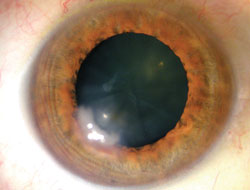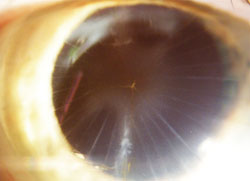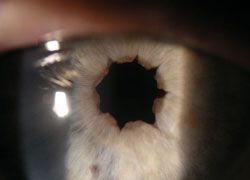Sometimes the best surgery is no surgery
Patients may have good intentions, but ophthalmologists understand the indications, risks, benefits and alternatives of surgical procedures.
 Uday Devgan |
In medical school, one of my mentors explained that, “Any surgeon can operate, but a great surgeon knows when not to do surgery.” This is particularly true in ophthalmology, where tissues are delicate and complications can negatively impact the patient’s vision. Ophthalmologists know to evaluate the indications, risks, benefits and possible alternatives of any procedure and present this to the patient so that an informed decision can be made.
Patients are more educated and well-read than ever before, and detailed information about ocular conditions and treatments can be found on the Internet, including footage of surgical procedures. But it is just not possible for a patient to become a “junior ophthalmologist” by digesting a dozen articles on the Internet. When treating patients, we often spend time countering ideas and dispelling myths that they have learned online. Ultimately, it is the surgeon who makes the final decision: If the patient desires a particular surgery but is not an ideal candidate, or the risks do not justify the potential benefits, the surgeon should be firm in the decision to not operate.
Case 1: Epithelial ingrowth, cataract
This patient had myopic LASIK performed more than 10 years ago with an enhancement procedure done more recently. The patient has developed a significant area of epithelial ingrowth that is inducing a large degree of astigmatism. While there is a cataract of 1+ to 2+ nuclear sclerosis, it does not adequately account for the 20/100 visual acuity. The patient, who works in the health care field, has read about the new presbyopia-correcting IOLs and now desires cataract surgery.
 Case 1: Case of epithelial ingrowth and cataract. Images: Devgan U |
In order to visually rehabilitate this eye, the surgeon must address the epithelial ingrowth before considering cataract surgery. This will involve lifting the flap, debriding the epithelial cells and perhaps tightly suturing the flap to prevent re-growth. Then, over the course of months, these sutures can be removed, and the patient’s cornea will likely stabilize. Once the cornea has consistent measurements and there is no evidence of epithelial ingrowth, the cataract surgery can be planned. The entire process can take up to a year, and the patient must be willing to endure this treatment to optimize vision. This patient decided to attempt a quick fix by having cataract surgery elsewhere.
Case 2: The never-ending quest for plano
Some patients have a very strong desire to achieve “perfect” plano, and they request multiple surgical procedures to correct their myopia. In this case, the patient had multiple sessions of radial keratotomy in order to address more than 10 D of myopia. This resulted in a cornea with 32 radial RK cuts and a small central optical zone. The patient then had cataract surgery performed about 1 year ago and, not surprisingly, ended up with residual hyperopia of +2 D. Slit lamp exam shows the numerous RK cuts, the small optical zone and a three-piece monofocal IOL. The patient desires surgical correction to achieve plano refraction.
 Case 2: After 32-cut RK, this patient underwent cataract surgery and ended up hyperopic. |
While there are surgical options for this patient, such as a piggyback IOL, an IOL exchange or perhaps even an excimer laser ablation, there is simply no way to give this patient perfection. The principle problem is the inherent instability of the cornea over time with a continuous shift toward more hyperopia that may last the patient’s lifetime. Thus, even if the eye is corrected to plano now, it may end up hyperopic again in the future. In addition, the aberrations induced by the RK cuts cannot be easily corrected. In this situation, it may be best for the patient to accept the current vision and seek non-surgical methods, such as spectacles, to correct any refractive error. The patient agreed and is happy in progressive glasses.
Case 3: Cosmetic pupil defect
This patient underwent cataract surgery a year ago, and because of a history of poor dilation, the surgeon elected to perform multiple small sphincterotomies along the pupil. The postoperative vision is good, and the patient sees well; however, she is very concerned about the cosmetic appearance of her eye. The small cuts to the pupil margin resulted in a star-shaped pupil that she sees in the mirror when applying eye make-up. The patient also has a history of background diabetic retinopathy with a normal macula and 20/25 vision. She is requesting a surgical correction of this cosmetic defect.
 Case 3: A cosmetic pupil defect from multiple iris sphincterotomies performed during cataract surgery. |
The iris is certainly a delicate structure, and manipulation during cataract surgery, such as stretching or cutting, can result in a cosmetic deformity. A lasso-type suture could be placed in a purse-string manner in order to surgically address this star-shaped pupil. However, the suture may hamper dilation of the pupil and make night vision more challenging and examination of the retina difficult. I advised the patient against any further surgical procedures. She was disappointed and saw another physician who did a nice job of suturing her iris; however, she developed macular edema and worsening of her diabetic retinopathy, and her vision declined.
Patients have good intentions, and they want what they think is best. However, lacking the in-depth knowledge of ophthalmologists, they may not fully understand the intricacies and implications of an ocular surgical procedure. Our job as surgeons is to help our patients by educating them, performing surgery when warranted and advising them against surgery when the risks outweigh the potential benefits. Indeed, sometimes the best choice is no surgery at all.

- Uday Devgan, MD, FACS, FRCS, is in private practice at Devgan Eye Surgery in Los Angeles and Beverly Hills. He can be reached at 11600 Wilshire Blvd., Suite 200, Los Angeles, CA 90025; 800-337-1969; fax: 310-388-3028; email: devgan@gmail.com; website: www.DevganEye.com.
- Disclosure: No products or companies are mentioned that would require financial disclosure.
